General info
- Ruellia is a genus of flowering plants commonly known as ruellias or wild petunia. However, they are not closely related to petunias (Petunia) although both genera belong to the same euasterid clade. (40)
- Ruellia tuberosa is a species of flowering plants in the family Acanthaceae
- The genus name honors Jean Ruelle (1474-1537), herbalist and physician to Francis I of France and translator of several works of Dioscorides.
(40)
Botany
• Ruellia tuberosa is a low-growing perennial
herb with tuberous roots, growing to a height of a foot or more. Leaves
are opposite, elliptic, short petioled, abruptly narrowed at the base,
with undulate margins and up to 12 centimeters long. Flowers are showy, with
funnel-shaped, 5-lobed corolla, up to 5 centimeters across, and mauve or light
bluish purple. Fruit is a pod with 7 to 8 seeds, bursting open and
hurtling the seeds when it gets wet.
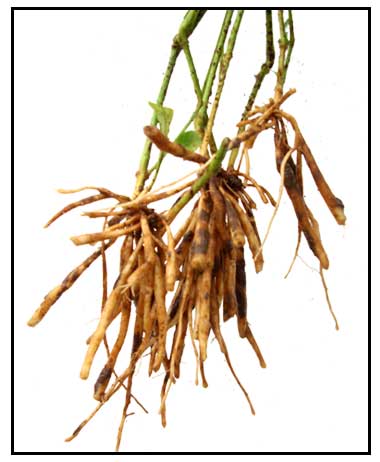 • Herbs to 45 cm tall, perennial, erect. Roots with elongate tuberlike swellings. Stems slightly swollen above nodes, almost 4-angled, strigulose on angles. Petiole to 8 mm, glabrous; leaf blade oblong-obovate, 4-8 × 1.5-4.2 cm, both surfaces glabrous, veins abaxially somewhat prominent, base cuneate and tapering onto petiole, margin undulate to subentire, apex acute. Inflorescences axillary, lax dichotomous cymes; peduncle to 2.3 cm; bracts oblong-lanceolate, to 3-9 × 1-3 mm; bracteoles linear-oblong, to 1.5 mm. Pedicel 6-10 mm, minutely pilose. Calyx tube to 6 mm, outside tomentose; lobes linear-lanceolate, 0.9-2 cm. Corolla pale blue, 2.2-5.5 cm, outside hirtellous; lobes suborbicular, ca. 1.6 × 1.5 cm. Stamens with longer pair ca. 8 mm and shorter pair ca. 4 mm; filaments glabrous; anther thecae white, hairy on dorsal side. Ovary glabrous except for a few gland-tipped trichomes at apex; style ca. 2.1 cm, sparsely hirsute; stigma 2-lamellate. Capsule not stipitate, linear-ellipsoid, 1.8-2.5 × 0.3-0.4 cm, glabrous except for a few gland-tipped trichomes at apex, 20-26-seeded; septa with attached retinacula remaining attached to inner wall of mature capsule. Seeds discoid, ca. 2 × 2 mm, covered with appressed hygroscopic trichomes. (Flora of China)
• Herbs to 45 cm tall, perennial, erect. Roots with elongate tuberlike swellings. Stems slightly swollen above nodes, almost 4-angled, strigulose on angles. Petiole to 8 mm, glabrous; leaf blade oblong-obovate, 4-8 × 1.5-4.2 cm, both surfaces glabrous, veins abaxially somewhat prominent, base cuneate and tapering onto petiole, margin undulate to subentire, apex acute. Inflorescences axillary, lax dichotomous cymes; peduncle to 2.3 cm; bracts oblong-lanceolate, to 3-9 × 1-3 mm; bracteoles linear-oblong, to 1.5 mm. Pedicel 6-10 mm, minutely pilose. Calyx tube to 6 mm, outside tomentose; lobes linear-lanceolate, 0.9-2 cm. Corolla pale blue, 2.2-5.5 cm, outside hirtellous; lobes suborbicular, ca. 1.6 × 1.5 cm. Stamens with longer pair ca. 8 mm and shorter pair ca. 4 mm; filaments glabrous; anther thecae white, hairy on dorsal side. Ovary glabrous except for a few gland-tipped trichomes at apex; style ca. 2.1 cm, sparsely hirsute; stigma 2-lamellate. Capsule not stipitate, linear-ellipsoid, 1.8-2.5 × 0.3-0.4 cm, glabrous except for a few gland-tipped trichomes at apex, 20-26-seeded; septa with attached retinacula remaining attached to inner wall of mature capsule. Seeds discoid, ca. 2 × 2 mm, covered with appressed hygroscopic trichomes. (Flora of China)
Distribution
- Introduced; naturalized.
-
In open waste places
in the Philippines.
- Occasionally, an escape from gardens in Manila and neighboring areas.
- Native to Aruba, Bahamas, Cayman Is., Colombia, Cuba, Dominican Republic, French Guiana, Guatemala, Guyana, Haiti, Honduras, Jamaica, Leeward Is., Mexico Gulf, Mexico Northeast, Mexico Northwest, Mexico Southeast, Mexico Southwest, Netherlands Antilles, Peru, Puerto Rico, Southwest Caribbean, Suriname, Trinidad-Tobago, Turks-Caicos Is., Venezuela, Venezuelan Antilles, Windward Is.
(9)
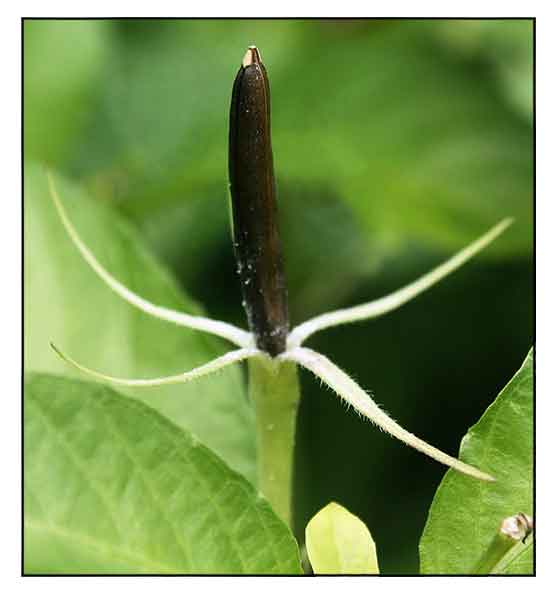 Constituents
Constituents
- Leaves contain apigenin
and luteolin.
- The seed oil yields myristic, capril and lauric acids.
- Study yielded flavonoids, glycosides, phenols, saponins and essential minerals with good nutritive value and secondary metabolites.
- Study for bioactive components of ethanol extract of tubers yielded 25 compounds viz. lupeol (68.14%), stigmasterol (8.89%), α-sitosterol (3.99%), sucrose (2.24%), cholest-5-ene, 3-bromo-, (3α- (2.24%), octadecane, 2-methyl- (2.10%), nonadecane, 2-methyl- (1.93%), eicosane, 2-methyl- (1.79%) heptacosane (1.43%) and heptacosane (1.29%). (13)
- Phytochemical screening of various extracts of whole plant yielded steroids, triterpenoids, phenols, flavonoid, tannin, sugars.
Physiochemical analysis yielded (%w/w) ash 13.53, acid insoluble ash 2.36, water insoluble ash 24.78, alcohol soluble extractive 7.67. (16)
- Methanolic extract of leaves yielded carbohydrates, glycosides, phytosteroids, flavonoids, tannins, fixed oils and fats. (see study below) (19)
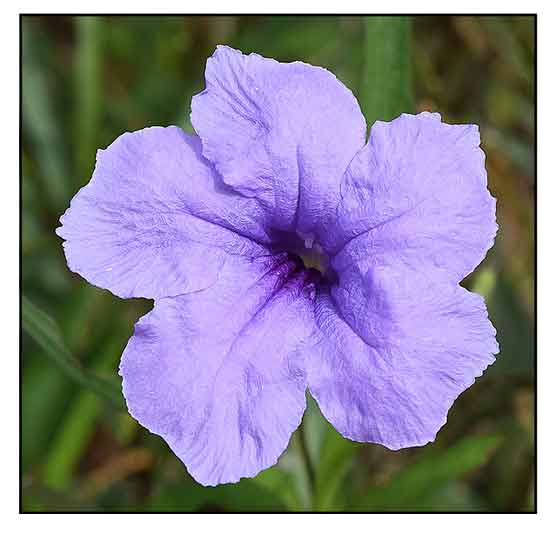 - GC and GC-MS analysis for volatile oils yielded 24 compounds in leaf oil (86.95%),
15 compounds in the stem oil (93.96%), 42 from the root oil (91.49%), 60 compounds from the fruit oil (89.68%), and 6 compounds
from flower oil (95.06%). Dominant compounds (%) were : leaf, E-phytol 21.06, tributylacetyl citrate 19.44, heptacosane 7.55; stem, m-xylene 33.83, hepatacosane 16.57, p-xylene 9.67; root, heptane 22.25, heptacosane 12.89, borneol 12.48; fruit, hexacosane 15.43, sextone 13.12, heneicosane 1.14; and flower, tributylacetyl citrate 67.78, 2-methyl-2-pentanol 10.15, 1-methyl-1-cyclopentanol 6.90. Important classes in the volatiles are monoterpenes, monoterpenoids, sesquiterpenes, sesquiterpenoids, hydrocarbons, aromatics, esters, alcohols, sulphur compounds, ketones, and aldehyde compounds. (30)
- GC and GC-MS analysis for volatile oils yielded 24 compounds in leaf oil (86.95%),
15 compounds in the stem oil (93.96%), 42 from the root oil (91.49%), 60 compounds from the fruit oil (89.68%), and 6 compounds
from flower oil (95.06%). Dominant compounds (%) were : leaf, E-phytol 21.06, tributylacetyl citrate 19.44, heptacosane 7.55; stem, m-xylene 33.83, hepatacosane 16.57, p-xylene 9.67; root, heptane 22.25, heptacosane 12.89, borneol 12.48; fruit, hexacosane 15.43, sextone 13.12, heneicosane 1.14; and flower, tributylacetyl citrate 67.78, 2-methyl-2-pentanol 10.15, 1-methyl-1-cyclopentanol 6.90. Important classes in the volatiles are monoterpenes, monoterpenoids, sesquiterpenes, sesquiterpenoids, hydrocarbons, aromatics, esters, alcohols, sulphur compounds, ketones, and aldehyde compounds. (30)
- Column chromatography of ethyl acetate fraction of whole plant yielded four compounds i.e., rutin (1), syringaresinol (2), catechin (3), and pulmatin (4).
(see study below) (37)
- GC-MS analysis of ethanol extract of tuber revealed 16 compounds
. The most abundant were flavone, E,E,Z-1,3,12-nonadecatriene 5, 14-diol, phytol, and methyl-6-octadecenoate, with relative peak areas of 50%, 41.8%, 41.4%, and 40.2%, respectively.
(42)
Properties
- In folk medicine, considered diuretic, antidiabetic, antipyretic, analgesic, antidotal.
-
Studies have suggested anti-inflammatory, antioxidant, antinociceptive, gastroprotective, renoprotective, male anti-fertility, antiproliferative, hypolipidemic, larvicidal, anti-carcinogenic, anti-diabetic, α-amylase inhibitory, erythropoietic, insecticidal, hepatoprotective, anti-urolithiatic, xanthine oxidase inhibitory, anthelmintic, phytoremediative, anti-parkinsonian properties.
Parts
used
Roots and leaves.
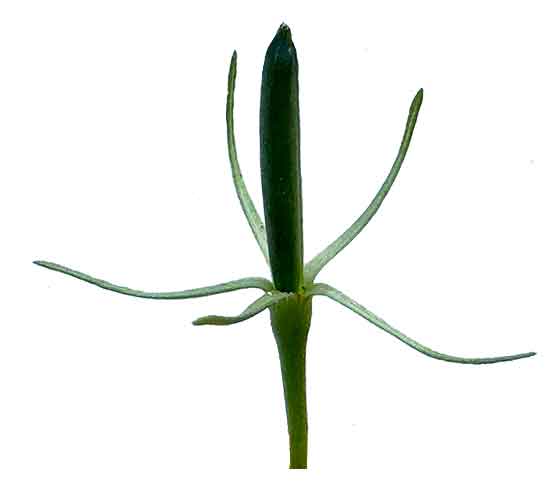 Uses
Uses
Folkloric
• No
reported folkloric medicinal use in the Philippines.
• In Trinidad
and Tobago, used as
a "cooling" agent, for urinary problems and high cholesterol.
• In Suriname's
traditional medicine, used as anthelmintic; for joint pains and muscle
strain. Also used as abortifacient. Root is used against kidney diseases
and whooping cough. Infusion used for cleansing the blood.
• Root and leaf used for alleviating urinary retention.
• Used for gonorrhea, syphilis, bladder stones, bronchitis and
cancer.
• In the Cayman Islands,
used for heart ailments.
• In Grenada,
used for common colds, fevers and hypertension.
• In the Dominican Republic, an
ingredient in a concoction for a male potency drink.
• In Sri Lankan traditional medicine, used for stomach problems.
• In India leaf juice applied to scorpion bite sites.
• In India, used for kidney stone disorders. (28)
• In Central America, used interchangeably with ipecacuanha to induce vomiting. Maya tribes apply the plant to mouth sores. Poultice of leaves used for aching leaves. Poultice of roots used for broken bones and dislocated joints. Plant also used for inducing abortion and treatment of fibroids.
(48)
Others
• Dye: Yields a dye, which is used for textiles.
(40) (41)
Studies
• Antinociceptive / Anti-Inflammatory:
Ethanol extract of Ruellia
tuberosa showed antinociceptive and anti-inflammatory activities with
maximum time response against thermal stimuli similar to that of diclofenac
and significant inhibition in serotonin and egg albumin-induced hind
paw edema in rats. The anti-inflammatory activity was comparable to
that of indomethacin. (1)
• Antioxidant:
Study showed that Ruellia
tuberosa possesses potent antioxidant activity. The results provide
information on its antioxidant related activity in its use in traditional
folk medicine. (4) Study of 50% hydroethanolic leaf extracts of Ruellia tuberosa and D. patulus showed they are not only useful in controlling peroxide level but also helpful in further strengthening the antioxidant potential. (24)
• Bioactive
Flavonoids / Cytotoxicity: Ethanol extract study
showed yielded five flavonoids –cirsimarin, cirsiliol 4'-glucoside,
sorbifolin, pedalitin, along with betulin, vanillic acid, and
indole-3-carboxaldehyde. Some compounds showed cytotoxicity against
KB and HepG2 cell line. (5)
• Gastroprotective / Analgesic / Roots: Study of crude aqueous extracts of Ruellia tuberosa roots in a rat alcohol-induced gastric lesion model showed a strong and dose-dependent gastroprotective activity. The extract also showed mild erythropoietic and moderate analgesic activities. (7)
• Hypolipidemic / Antioxidant: Study evaluated a powdered form of an ethanolic extract of Ruellia tuberosa for antilipidemic and antioxidant effects in hypercholesterolemic rats. Results showed addition of the powdered extract as a feed supplement reduces plasma lipid levels (cholesterol, triglycerides, LDL-C, and VLDL) with increased HDL-C and decreased lipid peroxidation. (10)
• Antiproliferative / Antioxidant: Study evaluated the antioxidant and antiproliferative activities of Ruellia tuberosa. An ethyl acetate leaf extract showed the highest radical scavenging activity. A methanol stem extract showed the highest anti-proliferative activity against MCF-7 cancer cells with IC50 of 22µg/ml. (11)
• Mosquito Larvicidal / Cx quinquefasciatus: Study evaluated the mosquito larvicidal activities of crude extracts of four plants viz. Alternanthera sessilis, Tremna orientalis, Gardenia carinata, and Ruellia tuberosa against Culex quinquefasciatus. A. sessilis showed the highest mortality followed by Ruellia tuberosa. (12)
• Anti-Carcinogenic / Antioxidant / Leaves: Study evaluated the anti-carcinogenic activity and antioxidant property of R. tuberosa methanol leaf extract on HepG2 cell line and RAW 264.7 murine macrophage cell lysate. Cytotoxicity by MTT assay showed an IC50 of 54.95 µg/ml on HepG2 cell line. Cells were arrested mostly in G0/G1 phase and also in G2/M phase of cell cycle. Results showed potent apoptogenic activity on HepG2 cell line and notable antioxidant activity on RAW 264.7 cell lysate. (14)
• α-Amylase Inhibitor / Betulin: Study evaluated R. tuberosa for compounds inhibiting α-amylase in rat and human by molecular docking. Analysis showed betulin could be a potential inhibitor with non-competitive pattern like betulinic acid. Betulin could have greater potential for α-amylase inhibition than acarbose—an assumption that needs to be verified in vitro. (17)
• Anti-Diabetic: Study evaluated the hypoglycemic activity of methanol extract and solvent fractions of R. tuberosa in alloxan-induced diabetic rats. An EaF at 100 mg/kg showed the highest anti-diabetic activity with a 28.64±0.28% decrease in blood glucose. Antioxidant activity by DPPH assay was the order of ethanol fraction>methanol extract >water fraction>n-hexane fraction. (18)
• Anti-Diabetic / Antihyperlipidemic / Hepatoprotective / Leaves: Study evaluated the anti-diabetic potential of methanolic extract of leaves in alloxan induced diabetic rats. The ME of leaves elicited significant reductions of blood glucose (p<0.05), lipid parameters except HDL-C, serum enzymes and significantly increased HDL-C at dose of 200mg/kg. (19)
• Anti-Cancer / EAC Induced Mammary Tumor: Study evaluated the antitumor effect of Ruellia tuberosa leaf extracts against Ehrlich ascites carcinoma (EAC) tumor in mice. Results showed decrease in tumor site and increase in life span of EAC tumor bearing mice. (20)
• Anti-Fertility / Roots: Study evaluated root powder of R. tuberosa for its effect on male reproduction in Swiss albino mice. Results showed a significant decrease in sperm count, motility, and viability (p<0.001). Results suggest Ruellia tuberosa has potential as reversible oral male contraceptive. (21) An aqueous extract of tuberous roots produced antispermatogenic effect in male albino rats. (26)
• Insecticidal
/ Antibacterial / Antifungal / Roots: Study evaluated a root extract for antibacterial, antifungal, and insecticidal activity. The methanol extract was active against all test bacteria and fungi. Insecticidal assay by film activity test showed strong insecticidal activity with 80% mortality of Tribolium castaneum. (22)
• Anti-Inflammatory / Tuber: Study evaluated ethanol extracts of tuber of R. tuberosa for anti-inflammatory activity in rats using carrageenan induced paw edema method. Results showed potent anti-inflammatory activity at 400 mg/kg. Indomethacin was standard reference drug. (23)
• Phytoremediation / Lead / Heavy Metal Pollution: Study showed Ruellia was a good accumulator of lead. The species can be recommended for the remediation of lead contaminated soils. Total accumulation was highest in the stem followed by roots and leaves. (25) Study evaluated Catharanthus roseus and Ruellia tuberosa for phytoremediation of lead, nickel, zinc, cadmium, and chromium contaminated soils. R. tuberosa highly accumulated Pb, Zn, and Cr. (35)
• α-Amylase Inhibitor / Anti-Diabetic: Study evaluated the antidiabetic mechanism of the n-hexane fraction of methanolic extract (HFME) of the plant in an in silico, in vivo and in vitro study in STZ induced diabetic rats. A single dose administration of HFME inhibited α-amylase activity in vivo. The extract also strongly inhibited the α-amylase activity in vitro (IC50 0.14 ± 0.005 mg/ml). (27)
• Antiurolithiatic / Antioxidant / Roots: Study evaluated an ethanolic extract of R. tuberosa roots for antiurolithiatic activity against 0.75% v/v ethylene glycol and 2% w/v ammonium induced calcium oxalate urolithiasis and for antioxidant activity against hyperoxaluria induced oxidative stress in male albino rats. Results showed significant reduction in deposition of calcium oxalate and increased urinary excretion of calcium, together with decreased lipid peroxidation and enhanced levels of antioxidant enzymes in the kidneys of urolithic rats. (28)
• Antioxidant / Leaves: Study evaluated the antioxidant property of aqueous leaf extract of Ruellia tuberosa. The extract concentration that protected DNA against oxidative damage also showed higher DPPH free radical scavenging activity. The extract also exhibited significant metal chelating activity. (•)
•
Camarosid / Antioxidant / Xanthine Oxidase Inhibitor / Leaves: Leaves of R. tuberosa have demonstrated strong antioxidant and xanthine oxidase inhibitory activities. Study isolated a flavonoids characterized as a methoxylated flavonoid, camarosid (5-hydroxy-3,7-dimethoxy-2-(4-((3S,4S,5S,6R)-4,5, 6-trihydroxy-2(hydroxymethoxy)-tetrahydro-2H-pyrane-3-iloxy) phenyl)-4H-chromen-4), which demonstrated DPPH free radical scavenging activity with IC50 OF 28.79 µg/ml and XOD inhibitory activity with IC50 of 0.67 µg/ml. (29)
• Hypolipidemic / Leaves: Study investigated the effect of 50% hydroethanolic leaf extracts of R. tuberosa and D. patulus on lipid profile in alloxan induced diabetic rats. Total cholesterol level was significantly (p<0.05) decreased at 500 mg/kg bw of both plant extract treated groups. HDL-c was found increased in the treatment groups. (31)
• Antidiabetic / Effect on Hepatic Histopathology / Malondialdehyde / Roots: Study evaluated a root extract of R. tuberosa on a diabetic rat model induced by STZ. Results showed lowered blood glucose levels, decreased MDA levels, and histopath evidence of recovery of hepatic organ. (32)
• Protective Against Abnormal Expression of Hepatic Detoxification Enzymes in Diabetic Rats: Study investigated extracts of R. tuberosa for effects on hepatic detoxicification enzyme expression in male diabetic Wistar rats with STZ-induced diabetes and fed with a HFD. Water and ethanol extracts significantly normalized expression of hepatic phase 1 and 2 detoxification enzymes in diabetic rats, along with reduction of glucose, HbA1c, and increased level of SOD in diabetic mice. Results suggest RT may ameliorate abnormal hepatic detoxification function via alleviation of hyperglycemia and enhancement of hepatic antioxidant capacity in HFD/STZ-induced diabetic rats. (33)
• Silver Nanoparticles / Mosquito Larvicidal / Leaves: Study reports on the green synthesis of silver nanoparticles using leaf extract of R. tuberosa. The NPs showed larvicidal activity against III and IV instar larvae of A. aegypti. Results suggest potential use for mosquito larvae control. (34)
• Ameliorative on Hyperglycemia of DM and Glucose Uptake in Mouse C2C12 Myoblasts: Study evaluated the effect of R. tuberosa aqueous and ethanolic extracts on hyperglycemia in HFD-fed STZ-induced T2DM rats. Results suggest RTL ameliorates hyperglycemia in HFD/STZ induced diabetic rats and may be attributed to the alleviation of insulin resistance (IR) in skeletal muscles. (36)
• Anti-Diabetic / Alpha-Glucosidase Inhibitory Activity: Study evaluated the anti-diabetic activities of various fractions of crude ethanolic extract of R. tuberosa. Results showed significant α-glucosidase inhibitory activity with IC50 of 15.84, 4.73, and 8.27 µg/ml of hexane, ethyl acetate, and methanol fractions, respectively. (see constituents above) (37)
• Hepatoprotective / Nitrosodiethylamine Induced Liver Injury: Study evaluated the protective effects of ethyl acetate and ethanolic extracts of Ruellia tuberosa against N-Nitrosodiethylamine-induced hepatocarcinogenesis in Wistar albino rats. Results showed hepatoprotective activity in measures of liver enzymes and histopathological examinations. (38)
• Anthelmintic / Aerial Parts: Study evaluated four abundant Philippine weeds i.e., C. aciculatus, C. brevifolius, S. spontaneum, and Ruellia tuberosa for anthelmintic activities. Hexane soluble and chloroform-soluble extracts were obtained through sequential partitioning of crude ethanolic extract of air-dried aerial parts of the plants. The extracts were tested against African nightcrawler earthworms Eudrillus euginiae. Anthelmintic bioassays showed dose-dependent toxicity relationship. For hexane extracts, R. tuberosa showed better activity than other samples. Among chloroform-soluble extracts, C. brevifolius and R. tuberosa showed strongest anthelmintic activities at all tested concentrations. (39)
• Antimicrobial: Study evaluated hydroethanolic extracts of R. tuberosa for anti-microbial activity against S. aureus and E. coli. Concentrations of 5, 10, 20, 50, 75, and 100% (v/v) resulted in inhibition zones range of 7.0-15.25 mm against S. aureus and 7.0-15 mm for E. coli. Commercial antibiotics, chloramphenicol and ampicillin used as control, showed inhibition zones of 30.20 and 25.70 mm for S. aureus, and 29.85 and 25.40 mm for E. coli. Extracts and antibiotics showed more potency against S. aureus. (43)
• Amelioration of Aortic Dysfunction: Study evaluated the protective effect of R. tuberosa ethanol extract against aorta dysfunction in high-fat diet (HFD) and streptozotocin (STZ)-induced type 2 diabetic rats. Results showed amelioration of serum lipid profiles and significantly reduced level of serum cytokines such as tumor necrosis factor-α (TNF-α) and interleukin-6 in T2DM rats. The extract also decrease endothelin-1 and endothelial nitric oxide contents, reduced level of cell adhesion factors. Extract also enhanced the activity of aorta antioxidative enzymes, includes superoxide dismutase and catalase in diabetic rats, suggesting amelioration of aorta dysfunction may be via enhancement of aortic antioxidative enzyme activity, which suppresses aorta endothelial damage-associated factors. (44)
• Improvement of Renal Histopathology / Roots: Study evaluated the effects of hydroethanolic root extracts of R. tuberosa on kidney of streptozotocin-induced diabetic Wistar rats.
Significant increases in TNF alpha e49xpression and malondialdehyde (MDA) levels were observed, along with severe histological alterations of kidney tissue of diabetic rats. Post treatment, TNF alpha expression and MDA levels decreased considerably. Treatments induced repairment of glomerular and renal tubular damages. (45)
• Acute Toxicity Study / Whole Plant: Study evaluated an ethanolic extract of whole plant for acute toxicity in Wistar albino mice using single doses of 200 and 400 mg/kbw and observed for 14 days. Results showed no mortality or adverse effects, suggesting nontoxicity at test doses, and potential for use as natural drug for pharmaceutical formulations. (46)
• Anti-Fertility / Effects on Sperm Count, Motility and Viability / Roots: Study evaluated the effect of root powder of R. tuberosa on male reproduction in Swiss albino mice.
Results showed significant decrease in sperm count, motility, and viability (p<0.001). Sperm count was reduced o 15.97-19.24 million/ml compared to control group of 55.12 million/ml. Partial reversal was noticed in the recovery group. Results suggest potential as reversible oral male contraceptive. (47)
• α-Glucosidase Inhibitory Activity / Leaves, Flowers, Roots: Study evaluated the inhibitory activity of leaves, flowers, and roots of R. tuberosa on α-glucosidase enzyme. Inhibition activity was based on the formation of yellow solution of p-nitrophenol compound resulting on the reaction between p-nitrophenyl-α-D-glucopyranoside (substrate) and α-glucosidase enzyme. Results showed inhibition activity of 9.97, % and 13.98% of leaves and flowers at extract concentration of7.8125 µg/mL, respectively, and 99.08% inhibition for roots at 31,25 µg/mL concentration. Results suggest potential for the leaves, flowers, and roots as inhibitor of the enzyme α-glucosidase. (49)
• α-Glucosidase / Aldose Reductase / DPP-4 Inhibitors: Study evaluated the compounds from R. tuberosa involved in the inhibition of aldose reductase, dipeptidyl peptidase 4 (DPP-4), and
α-glucosidase. Molecular docking and complexes MM/GBSA showed specific interactions and high binding free energies. ADMET prediction demonstrated excellent safety profile, pharmacokinetic characteristics, and favorable drug-likeness of betulin, betulinic acid, cirsiliol, cirsimarin, cirsimaritin, and pedalitin. Study showed inhibition potential of Rt compounds against aldose reductase, DPP-4, and α-glucosidase inhibitors. (50)
• Anticancer Potential / Human Triple-Negative Breast Cancer / Flowers: Study evaluated the
anticancer potential of methanolic extract of Rt flower with emphasis on human triple-negative breast cancer (TNBC) and the possible signaling networks and regulatory pathways underlying it. RTME exhibited significant in-vitro cytotoxicity along with reduction in colony formation and inhibition of cell migratory potential in MDA-MB-231 cells. RYME also induced intracellular ROS, promoted G0/G1 cell cycle arrest, caused mitochondrial membrane potential (MMP) alteration, and promoted cell death. RTME promoted the intrinsic pathway of apoptosis. In-silico molecular docking study showed that three identified lead phytochemicals showed strong receptor-ligand interactions with anti-apoptotic Bcl-2, suggesting a clue to the possible molecular mechanisms. Results suggest potential of RTME against TNBC and an alternative option for anticancer drug development. (51)
• Anti-Parkinsonian Activity / Leaves: Study evaluated the anti-parkinsonian activity of hydroalcoholic extract of R. tuberosa leaves in rat models. Catalepsy was induced in rats using Rotenone and HART. Behavioral changes were assessed using the hole board test for catalepsy, motor coordination test by rotarod, and locomotor activity by actophotometer. The extract showed antiparkinsonian activity. Catalepsy was reduced and locomotor activity was improved. Results suggest a potential therapeutic agent for the treatment of Parkinson's disease. (52)
• Anti-Breast Cancer / Leaves: Study evaluated the mode of action of ethyl acetate extract of Ruellia tuberosa leaves (RTEAL) for its inhibitory effect on human breast cancer cell line, MCF-7. RTEAL was found to selectively inhibit proliferation of MCF-7 cells with IC50 of 28 µg/mL. DNA laddering observed morphological changes consisting of nuclear fragmentation and chromatin condensation.. RTEAL induced apoptotic pathways by inhibiting the expression of anti-apoptotic BCL-2 while upregulating pro-apoptotic BAX, caspase 7 and caspase 8. RTEAL
caused cell cycle arrests at S and G2/M phase and dysregulation of cell cycle regulators. Results collectively demonstrate RTEAL
extract inhibited cell growth by inducing apoptosis and cell cycle arrest, suggesting therapeutic potential against breast cancer. (53)
Availability
- Wild-crafted.
- Seeds and herbs in the cybermarket.

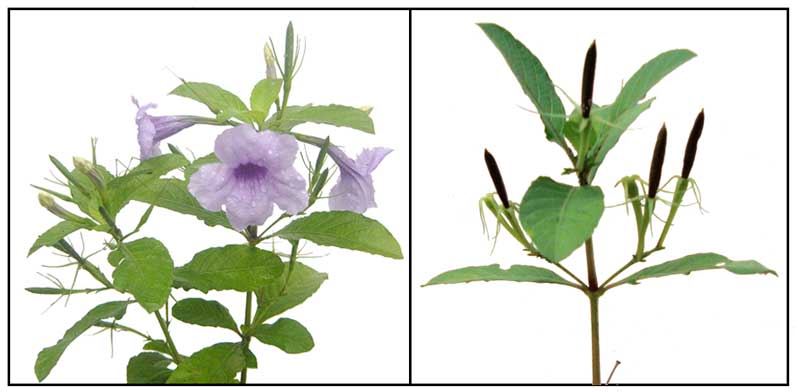
![]()

